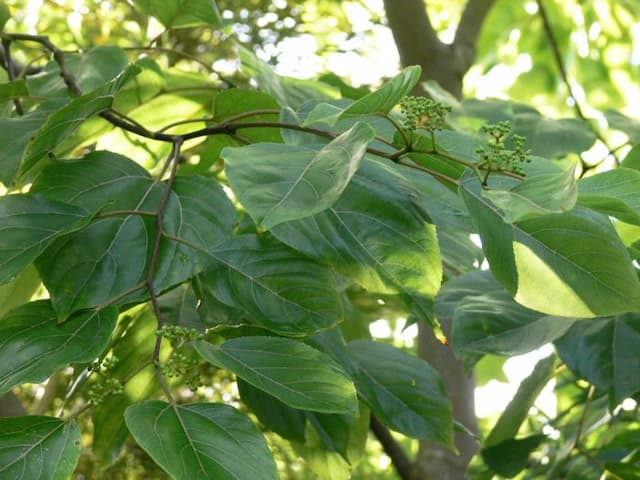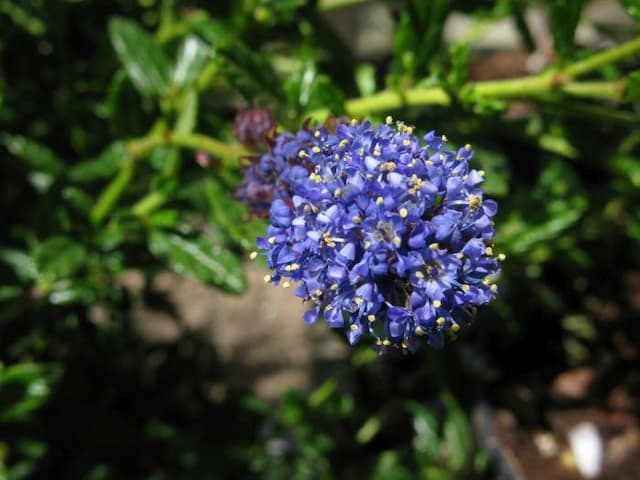Variegated Italian Buckthorn Rhamnus alaternus 'Argenteovariegata' (v)

ABOUT
The Variegated Italian Buckthorn is an evergreen shrub known for its striking foliage. This plant features leaves that are broadly oval with pointed tips and have a leathery texture. The most distinctive aspect of these leaves is their variegation; they are edged with a creamy white border that contrasts beautifully with the dark green center. The leaves are arranged alternately along the stems, creating a dense and lush appearance that can add visual interest to any landscape. New growth on the Variegated Italian Buckthorn often has a pinkish hue, which further enhances the decorative appeal of the plant. Aside from the foliage, the Variegated Italian Buckthorn produces small, inconspicuous flowers in the spring. These flowers are followed by reddish-black berries that can attract birds and other wildlife to the garden. Overall, the Variegated Italian Buckthorn is appreciated for its variegated leaves, which provide year-round color and texture, making it an attractive choice for hedges, borders, or as a stand-alone specimen. Its adaptability and ornamental qualities make it a valuable addition to a variety of garden settings.
About this plant
 Names
NamesFamily
Rhamnaceae
Synonyms
Variegated Italian Buckthorn, Variegated Mediterranean Buckthorn
Common names
Alaternus argenteovariegatus, Rhamnus alaternus 'Variegata', Rhamnus alaternus var. argenteovariegata.
 Toxicity
ToxicityTo humans
The Italian Buckthorn is considered to have some level of toxicity to humans. While it's generally not considered lethal, ingestion of parts of this plant can lead to gastrointestinal upset, including symptoms such as nausea, vomiting, diarrhea, and abdominal pain. Care should be taken to ensure that children do not consume the berries or other parts of the plant.
To pets
Like humans, pets can also experience toxicity from the Italian Buckthorn. If a pet ingests parts of this plant, particularly the berries, it could suffer from symptoms similar to those in humans, which include vomiting, diarrhea, and abdominal discomfort. Pet owners should prevent their animals from ingesting any part of the plant to avoid these adverse effects.
 Characteristics
CharacteristicsLife cycle
Perennials
Foliage type
Evergreen
Color of leaves
Variegated
Height
6-8 feet (1.8-2.4 meters)
Spread
5-6 feet (1.5-1.8 meters)
Plant type
Shrub
Hardiness zones
7
Native area
Mediterranean
Benefits
 General Benefits
General Benefits- Aesthetic appeal: The Rhamnus alaternus 'Argenteovariegata', also known as the Variegated Italian Buckthorn, has attractive creamy white and green variegated leaves that provide visual interest to any garden or landscape.
- Drought tolerance: Once established, it is quite tolerant to drought, making it suitable for xeriscaping and water-conservative gardens.
- Low maintenance: This shrub requires minimal care beyond occasional pruning to maintain its shape, making it a convenient choice for busy gardeners.
- Habitat creation: The plant can provide cover and food for wildlife, such as birds, which may feed on its berries when they mature.
- Privacy and screening: With its dense foliage, the Variegated Italian Buckthorn can act as an effective privacy screen or hedge in a garden setting.
- Soil stabilization: Its root system can help prevent soil erosion on slopes or in areas prone to losing topsoil.
- Adaptability: It is able to adapt to a range of soil types and conditions, which makes it a versatile addition to various landscapes.
- Evergreen nature: As it keeps its foliage year-round, it provides constant greenery and structure to gardens across the seasons.
 Medical Properties
Medical PropertiesThis plant is not used for medical purposes.
 Air-purifying Qualities
Air-purifying QualitiesThis plant is not specifically known for air purifying qualities.
 Other Uses
Other Uses- Variegated Italian Buckthorn can be used to create intricate topiaries due to its dense foliage and ability to tolerate pruning well, making it a favorite for formal garden designs.
- The plant's berries have been used to make natural dyes, providing a range of colors from green to yellow, depending on the mordant used in the process.
- Due to its dense growth, Variegated Italian Buckthorn can serve as a sound barrier, helping to reduce noise pollution in urban gardens and landscapes.
- The branches of Rhamnus alaternus 'Argenteovariegata' are sometimes used in floral arrangements, as the variegated leaves add contrast and visual interest.
- Its tough wood has historically been utilized in the creation of small wooden tools or intricately carved objects, taking advantage of its hardness and durability.
- The plant can act as a host for certain species of butterflies and moths, providing a habitat and food source for caterpillars, thus supporting local biodiversity.
- Variegated Italian Buckthorn's berries, although not edible for humans, can provide a food source for wildlife during the winter months when other food is scarce.
- In coastal areas, the plant is employed as a windbreak to protect more sensitive plants since it can withstand strong winds and salt sprays.
- The dense root system of Variegated Italian Buckthorn helps in soil stabilization, making it useful for planting on slopes to prevent soil erosion.
- Its evergreen variegated foliage can be used to create a backdrop in photography or as a setting for outdoor events, providing a year-round aesthetic appeal.
Interesting Facts
 Feng Shui
Feng ShuiThe Italian Buckthorn 'Argenteovariegata' is not used in Feng Shui practice.
 Zodiac Sign Compitability
Zodiac Sign CompitabilityThe Italian Buckthorn 'Argenteovariegata' is not used in astrology practice.
 Plant Symbolism
Plant Symbolism- Versatility: Rhamnus alaternus 'Argenteovariegata', commonly known as Italian Buckthorn, often symbolizes versatility due to its variegated leaves and adaptability to different environments.
- Resilience: The robust nature of Italian Buckthorn, being drought-tolerant and able to grow in a variety of conditions, makes it a symbol of resilience and surviving through hard times.
- Growth: With its vigorous growth habit, Italian Buckthorn can represent personal growth or the flourishing of a project or endeavor.
- Protection: Historically, buckthorns have been used to create hedges, which can symbolize setting boundaries or offering protection.
- Balance: The variegation of the leaves of 'Argenteovariegata' displays a balance of green and cream colors, which can be interpreted as a symbol of balance and harmony in life.
 Water
WaterThe Italian Buckthorn 'Argenteovariegata' requires regular watering, especially during its growing season in spring and summer. It should be watered thoroughly when the top inch of soil becomes dry to the touch, which could be about once a week, depending on the climate and soil drainage. Provide the plant with approximately 2 gallons of water per watering session to ensure deep soil penetration, but adjust as needed to prevent waterlogging. During fall and winter, reduce watering frequency to every other week or less, as the plant's water requirements decrease.
 Light
LightItalian Buckthorn 'Argenteovariegata' thrives in full sun to partial shade. The best spot for this plant would provide access to at least six hours of direct sunlight per day, although it can also tolerate some shade. Avoid deep shade locations, as too little light can diminish the plant's variegated foliage color and overall health.
 Temperature
TemperatureItalian Buckthorn 'Argenteovariegata' can tolerate a wide temperature range, generally between 20°F to 100°F. However, the ideal temperature range for this plant is between 65°F and 85°F. The plant is hardy and can survive occasional cold snaps, but prolonged exposure to temperatures below 20°F can be harmful.
 Pruning
PruningPrune Italian Buckthorn 'Argenteovariegata' to maintain its shape and remove any dead or damaged branches, which will promote healthy growth. The best time for pruning is late winter to early spring before new growth begins. Prune the plant annually, or as needed, to manage its size and to encourage the growth of foliage, which is often more vibrant on new stems.
 Cleaning
CleaningAs needed
 Soil
SoilItalian Buckthorn (variegated) prefers well-draining soil with organic matter. A mix of two-thirds loam and one-third peat or compost works well. Aim for a soil pH between 6.0 and 7.5 for optimal growth.
 Repotting
RepottingItalian Buckthorn (variegated) should be repotted every 2-3 years or when it becomes root-bound. Early spring is the best time for repotting to allow the plant to establish before the growing season.
 Humidity & Misting
Humidity & MistingItalian Buckthorn (variegated) is adaptable to a range of humidity levels but prefers moderate to high humidity. Average room humidity should be sufficient, but it can benefit from occasional misting.
 Suitable locations
Suitable locationsIndoor
Provide bright light, well-draining soil, and water when the topsoil dries.
Outdoor
Choose a sunny spot, plant in well-drained soil, and water regularly.
Hardiness zone
7-10 USDA
 Life cycle
Life cycleItalian Buckthorn (Variegated) generally starts its life cycle with seed germination, where environmental conditions such as moisture and temperature trigger the growth of a new plant from a seed. The plant then enters a vegetative stage where it grows leaves, stems, and roots, primarily focusing on accumulating size and strength. As it matures, the Italian Buckthorn (Variegated) will begin to produce flowers, which are small and not particularly showy, through a process called flowering or blooming. Following the flowering stage, pollination occurs, often with the help of insects or wind, leading to the production of fruits which in the case of Italian Buckthorn are small berries. Once the berries ripen, they fall to the ground or are consumed by animals, allowing seeds to disperse and potentially grow into new plants. The Italian Buckthorn (Variegated) then continues this cycle or enters a period of dormancy during adverse conditions, resuming growth as conditions improve.
 Propogation
PropogationPropogation time
Spring-Early Summer
Propogation: The Italian Buckthorn 'Argenteovariegata', a variegated form of Rhamnus alaternus, is most commonly propagated through semi-hardwood cuttings. The best time to take these cuttings is in the late summer, as this allows the cuttings to establish roots before the cooler winter months set in. To propagate, select healthy semi-hardwood stems that have matured from the current year's growth and cut sections that are about 4 to 6 inches long (approximately 10 to 15 centimeters). Make a clean cut just below a leaf node, strip the lower leaves, and dip the cut end into a rooting hormone to encourage root growth. The cuttings should then be placed in a well-draining soil mix, ensuring that at least two nodes are below the soil surface. A high humidity environment is often maintained to prevent the cuttings from drying out before they can develop roots. After a few weeks to months, depending on growth conditions, the cuttings should develop a healthy root system and can be transplanted into individual pots or into the landscape.









